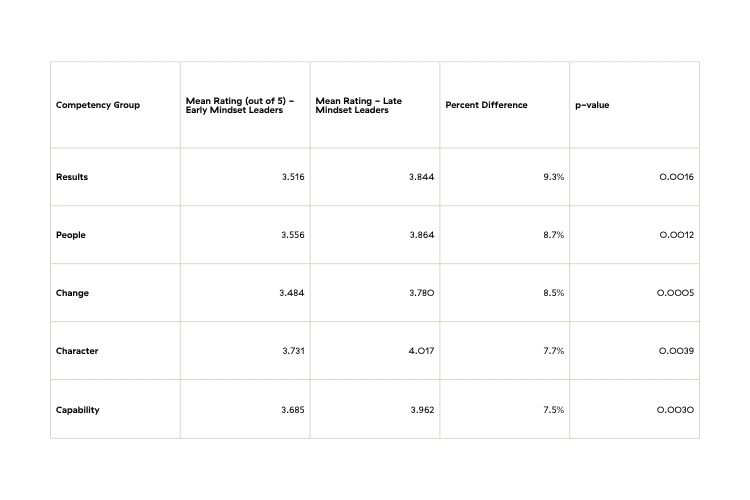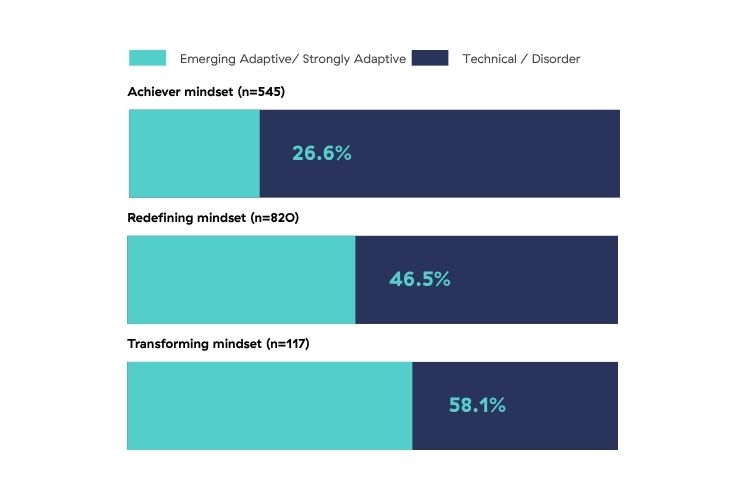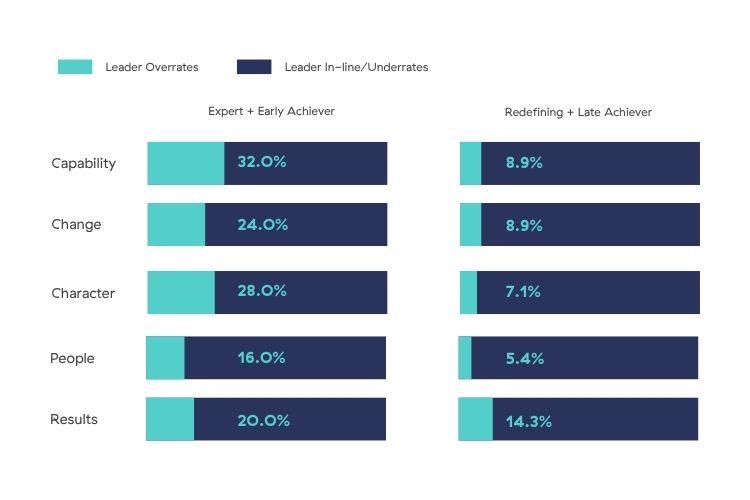Links to more information
- A leaders guide to mindset development (vertical development, mindset development, mindsets)
- Leadership Mindset Indicator
- Adeption 36O
To understand the factors behind effective leadership, we have built and analyzed a dataset from the past ten years of our work. This includes quantitative and qualitative data from over 1OO,OOO leaders, including 3 million answers to coaching questions and 4OO,OOO written reflections. The following is detailed information about the five data analysis we conducted to create the report – Invest in mindset. Invest in leadership.
- Clearer, More Purposeful Plans
In three programs, 1546 actions by 381 leaders were collected and manually scored across 3 dimensions (What, Why, and When) to capture key aspects of an ideal action plan.
The scores in each dimension ranged from O (low/absent) to 2 (high) with a simplified summary of the schema being:
What: O = no clear action identified; 1 = action identified but no discussion of how; 2 = clear action and approach discussed
Why: O = no purpose or envisioned outcome mentioned; 1 = clear purpose for action mentioned; 2 = clear purpose and envisioned outcome discussed
When: O = no mention of when action will be done; 1 = mention of an intention to find a time for action; 2 = clear when, or how often, action will be done
Leadership Mindset Indicator (LMI) results for all leaders were included. For most two scores were available (one from the beginning and the end of the program). When analyzing by mindset the highest measured mindset was used as this was the largest range of mindset that we had evidence they could access.
Rather than exploring individual mindsets, leaders were classed as Later Mindset if they showed evidence of a Redefining mindset or later, and Early Mindset if there was no evidence of mindsets accessed later than Achieving.
Late Mindset Leaders were significantly more likely to talk in detail about how they intended to complete their action (What = 2), and lay out a clear purpose with expected outcomes for what they are expecting their action to achieve (Why = 2), than Early Mindset leaders. This was true across all 4 programs.
This was confirmed statistically using linear regression that took into account the differences due to different programs/organizations. Even after accounting for program differences, Late Mindset leaders were associated with an 11.6-29.1% increase in What scores, and a 6.8-28.5% increase in Why scores.
This dataset has also been used in the Adeption Insights Series Report – Strengthening the Action-Reflection link for leadership growth.
2. Greater Leadership Competencies
This analysis is drawn from a sample of 81 leaders from one organization over a two-year period who completed both Leadership Mindset Indicator (LMI) stems and an Adeption 36O assessment at the beginning of a program. This data enabled us to assess their current mindset, and captured how their colleagues rated their leadership skills before they started the development program. With all leaders in the sample coming from a single organization within a short time period, this helps to control for other factors that may affect results, given these leaders were all working within a similar context and period of the organization’s history.
Leaders were split into two groups based on their LMI scores: Early Mindset leaders (comprising those with scores in Expert and early Achieving, n = 25), and Late Mindset leaders (scores in later Achieving and Redefining, n = 56)
Adeption 360 Competency Clusters and what each captures feedback on
Character: A leader’s positivity, integrity, courage, self-awareness, and resilience.
Capability: How well a leader applies expertise, solves problems, innovates, and makes decisions.
Results: A leader’s ability to plan and organize, set standards, drive energy, and hold themselves accountable for achieving results.
People: How well a leader communicates, collaborates, promotes teamwork, builds relationships, and develops others.
Change: A leader’s ability to champion change, think strategically, create vision and purpose, and connect outside the organization.
Across all five leadership competency clusters assessed in the Adeption 36O, Late Mindset leaders received higher ratings on average than Early Mindset leaders. The differences ranged from 7.5% higher in Capability ratings, to 9.3% higher in Results. All were statistically significant at a high level (All had p-values < O.O1 making them significant at the 1% level, based on a Wilcoxon Rank Sum test.)
Table 1: Mean Adeption 36O Competency Group ratings

This dataset has also been used in the Adeption Position Paper – How your mindset impacts your leadership capability
3. Adaptive Approaches to Challenges
The data used in this analysis comes from 1532 responses to the question ‘What is your current biggest leadership challenge, and how are you approaching it?’ from the Leadership Mindset Indicator assessment digital debrief on the Adeption platform. All responses were free text and at least 3O words long. This is a cross-organizational sample. Due to the nature of the data export the number of organizations in the sample is unknown.
Their challenges were tagged with the relevant theme tags from a total of 25 possible themes.
Their overall framing was assessed using a bespoke Adaptive-Technical framework into either Disordered, Technical, Emerging Adaptive, Strongly Adaptive.
Their results were further split by their Leadership Mindset to explore differences between these mindsets. Only Achieving, Redefining, and Transforming were retained, as other mindsets were too few for an appropriate analysis.
The bespoke Adaptive-Technical framework used three dimensions:
- Protection (Technical) vs. Exposure (Adaptive)
- Simple Solution (Technical) vs. Complex Evolution (Adaptive)
- Resources and Constraints
Responses were scored as Uncertain where the dimensions above were not clear or unmentioned. Evidence from at least two was required to give an overall Adaptive-Technical rating.
Uncertain: The challenge is vague or poorly described, with little to no discussion of the approach taken.
Technical: The challenge is framed as a threat or annoyance to the status quo, solvable with a known solution and people playing their fixed roles. Requires, and is constrained by, a lack of discrete resources (time, staff, expertise, money, etc.).
Emerging Adaptive: The challenge and approach have some aspects of Strongly Adaptive framing, but are not consistent or fully developed. Technical framing may still be present.
Strongly Adaptive: The challenge and approach described as a valuable opportunity to adapt and experiment to create new norms. The solution is not known, or a ‘right’ answer may not exist. The issue is framed as key questions or polarities, and the resources needed are buy-in, collaboration, and alternative perspectives. Constrained by resistance to change.
Figure 1: Adaptive-Technical Framing by Leadership Mindset

This dataset has also been used in the Adeption Insights Series Report – Why leaders struggle with self-development
4. Increased Self-Awareness
This analysis is drawn from a sample of 81 leaders from one organization over a two-year period who completed both Leadership Mindset Indicator (LMI) stems and an Adeption 36O assessment at the beginning of a program. This data enabled us to assess their current mindset, and captured how their colleagues rated their leadership skills before they started the development program. With all leaders in the sample coming from a single organization within a short time period, this helps to control for other factors that may affect results, given these leaders were all working within a similar context and period of the organization’s history.
Leaders were split into two groups based on their LMI scores: Early Mindset leaders (comprising those with scores in Expert and early Achieving, n = 25), and Late Mindset leaders (scores in later Achieving and Redefining, n = 56)
Adeption 360 Competency Clusters and what each captures feedback on
Character: A leader’s positivity, integrity, courage, self-awareness, and resilience.
Capability: How well a leader applies expertise, solves problems, innovates, and makes decisions.
Results: A leader’s ability to plan and organize, set standards, drive energy, and hold themselves accountable for achieving results.
People: How well a leader communicates, collaborates, promotes teamwork, builds relationships, and develops others.
Change: A leader’s ability to champion change, think strategically, create vision and purpose, and connect outside the organization.
In our sample we discovered that overall, the majority of leaders do not overrate themselves relative to their colleagues (Cases where leaders rated themselves at least O.2 points higher than their colleagues did.). However, in several Competency Groups, Early Mindset leaders were more likely to overrate themselves than their Later Mindset counterparts. These differences were most significant in Capability, Change, and Character.
Figure 2: Proportions of leaders who rated themselves higher than their colleagues did (overrated) in each Competency Group, split by mindset.

This dataset has also been used in the Adeption Position Paper – How your mindset impacts your leadership capability
5. Mindset Growth in Leadership Development Programs
Leadership Mindset Indicator (LMI) sentence stems were integrated at the start and the end of each development experience included in this analysis. We looked at the results of these assessments from 674 people on 3 separate programs who had completed LMI stems at the beginning and end of their programs. Of these, there were 282 who tested below Redefining at the beginning of the program (Diplomat, Expert, and Achiever mindsets). The analysis of mindset growth for this subgroup was:
51.4% of these participants moved into a later (higher) leadership mindset
7.1% of these participants progressed by two leadership mindsets.
The data has high validity – participants were not aware that these questions related to leadership mindsets in the Adeption experience, so this removes any potential bias in the way the questions were answered. LMI scoring is also carried out by AI so this mitigates individual scoring bias in the processing of results.
This dataset has also been used in the Adeption Insights Series Report – Mindset growth through leadership development.
